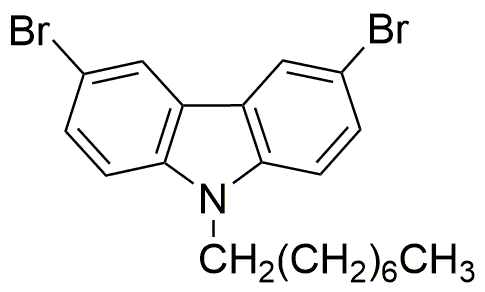3,6-Dibromo-9-n-octylcarbazole is widely utilized in research focused on:
- Organic Electronics: This compound is used in the development of organic light-emitting diodes (OLEDs), enhancing the efficiency and color purity of displays in televisions and smartphones.
- Photovoltaic Cells: It serves as a material in organic solar cells, contributing to improved energy conversion efficiency, which is crucial for sustainable energy solutions.
- Fluorescent Sensors: The compound is employed in creating fluorescent sensors for detecting environmental pollutants, aiding in environmental monitoring and protection.
- Polymer Chemistry: It acts as a building block for synthesizing advanced polymers, which are used in coatings and adhesives, providing enhanced durability and performance.
- Biological Research: This chemical is utilized in studies investigating its potential as a therapeutic agent, particularly in cancer research, due to its unique structural properties.
General Information
Properties
Safety and Regulations
Applications
3,6-Dibromo-9-n-octylcarbazole is widely utilized in research focused on:
- Organic Electronics: This compound is used in the development of organic light-emitting diodes (OLEDs), enhancing the efficiency and color purity of displays in televisions and smartphones.
- Photovoltaic Cells: It serves as a material in organic solar cells, contributing to improved energy conversion efficiency, which is crucial for sustainable energy solutions.
- Fluorescent Sensors: The compound is employed in creating fluorescent sensors for detecting environmental pollutants, aiding in environmental monitoring and protection.
- Polymer Chemistry: It acts as a building block for synthesizing advanced polymers, which are used in coatings and adhesives, providing enhanced durability and performance.
- Biological Research: This chemical is utilized in studies investigating its potential as a therapeutic agent, particularly in cancer research, due to its unique structural properties.
Documents
Safety Data Sheets (SDS)
The SDS provides comprehensive safety information on handling, storage, and disposal of the product.
Product Specification (PS)
The PS provides a comprehensive breakdown of the product’s properties, including chemical composition, physical state, purity, and storage requirements. It also details acceptable quality ranges and the product's intended applications.
Certificates of Analysis (COA)
Search for Certificates of Analysis (COA) by entering the products Lot Number. Lot and Batch Numbers can be found on a product’s label following the words ‘Lot’ or ‘Batch’.
*Catalog Number
*Lot Number
Certificates Of Origin (COO)
This COO confirms the country where the product was manufactured, and also details the materials and components used in it and whether it is derived from natural, synthetic, or other specific sources. This certificate may be required for customs, trade, and regulatory compliance.
*Catalog Number
*Lot Number
Safety Data Sheets (SDS)
The SDS provides comprehensive safety information on handling, storage, and disposal of the product.
DownloadProduct Specification (PS)
The PS provides a comprehensive breakdown of the product’s properties, including chemical composition, physical state, purity, and storage requirements. It also details acceptable quality ranges and the product's intended applications.
DownloadCertificates of Analysis (COA)
Search for Certificates of Analysis (COA) by entering the products Lot Number. Lot and Batch Numbers can be found on a product’s label following the words ‘Lot’ or ‘Batch’.
*Catalog Number
*Lot Number
Certificates Of Origin (COO)
This COO confirms the country where the product was manufactured, and also details the materials and components used in it and whether it is derived from natural, synthetic, or other specific sources. This certificate may be required for customs, trade, and regulatory compliance.


